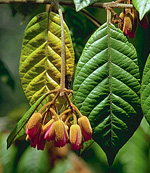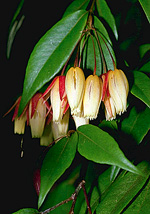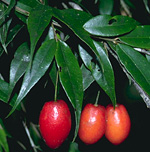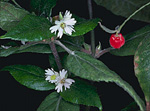 |
This family has a centre of diversity in Australasia and the Western Pacific. In Australia many members are characteristic of rain forests (both tropical and temperate) and wet sclerophyll forests from the Top End of the Northern Territory around the wetter parts of the east coast to Tasmania.
Characteristic features of the family Elaeocarpaceae in Australia include: - trees or shrubs, large and woody or (Aristotelia) soft and almost herbaceous
- leaves usually toothed, alternate or opposite, often with prominent reticulate veins, often with a swelling at the base and apex of the periole (double pulvinus), often turning red with age
- petals 4 or 5, often lacerate or fringed like a lamp-shade
- stamens few to many, the anthers often arranged pressed together around the style, opening by terminal pores or short slits
- ovary superior; fruit a capsule or drupe, and then often blue or black with a pitted stone
Description
Evergreen trees or shrubs. Internal secretions not obvious. Plants glabrous or with simple, glandular or non-glandular, unicellular hairs. Leaves alternate and spiral, or opposite, or in whorls or pseudo-whorls, petiolate; pulvinae present or absent. Stipules apparently absent or present and distinct and free from petiole, bristle-like, falling off early. Lamina simple, symmetric, lanceolate, ovate, elliptic, oblanceolate, obovate or oblong; base cuneate, cordate, attenuate or rounded; margins entire, crenate, dentate or serrate, ±flat, revolute or recurved; venation pinnate, with the midrib conspicuous, and the tertiary venation reticulate; surfaces not punctate; leathery or herbaceous. Domatia absent or consisting of pits, pockets or hair tufts in the vein angles. All the flowers bisexual. Inflorescences axillary or terminal, consisting of racemes, panicles, dichasial cymes or solitary flowers. Bracts and bracteoles absent. Pollination by insects. Flowers odourless; stalked. Floral disc present. Perianth regular, of 2 dissimilar whorls or of 1 whorl only or all whorls ±similar. Calyx segments free, with (4–) 5 sepals, valvate in bud, herbaceous. Corolla segments free, with 0 or (4–) 5 petals, alternating with the sepals, valvate or rarely imbricate, white, cream or pink, without contrasting markings, membranous; claws absent; lobes trifid, trilobed or more divided or ciliate or fimbriate. Fertile stamens numerous, not clearly correlated with the sepals, free of the corolla, free of the ovary and style, distinct from each other, all ±equal. Anthers dorsifixed, not versatile, opening terminally by short slits, 2-celled, with appendages absent or apical. Ovary superior and sessile. Carpels 2–5, fused; ovary with 2–5 locules. Style terminal, single and unbranched, with the stigma penicillate. Ovules 1–6 per locule, sessile; placentation axile. Fruit dehiscent or indehiscent; a dry septicidal capsule or a fleshy drupe; the perianth on the maturing fruit deciduous. Disseminule micro-surface ±smooth, red, blue or black, glossy. Seeds 1–2 per fruit. Aril present or absent. Cotyledons 2. Embryo straight or curved.
(Note: this description has been generated from the coded data compiled for the key. Any errors in the key data will be reflected in the descriptions.)
A treatment of the family Elaeocarpaceae has not yet been published in the Flora of Australia. It will appear in Volume 7.
Australian genera of Elaeocarpaceae (as recognised for the Flora of Australia)
Aceratium
Aristotelia
Debouzetia
Elaeocarpus
Peripentadenia
Sloanea

|
  |

Aceratium ferrugineum (flowers)
Photo: H.Nicholson © H. & N. Nicholson

Aceratium megalospermum (flowers)
Photo: D.Jones © D.Jones

Aceratium sericoleopsis (fruits)
Photo: H.Nicholson © H. & N. Nicholson

Aristotelia australasica (flowers and fruit)
Photo: M.Fagg © M.Fagg

|

| |